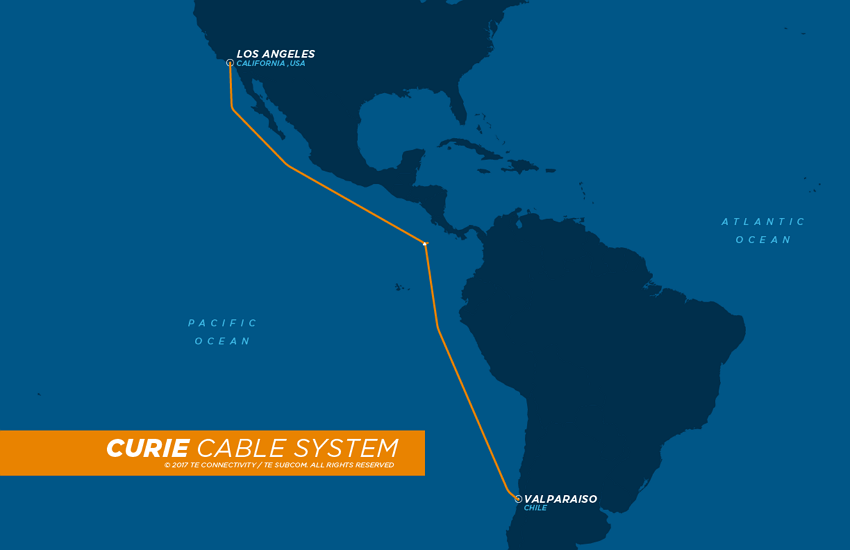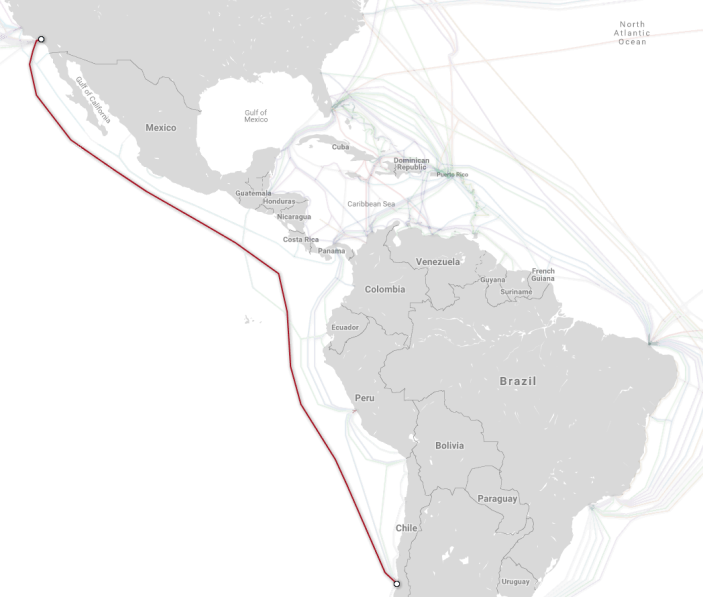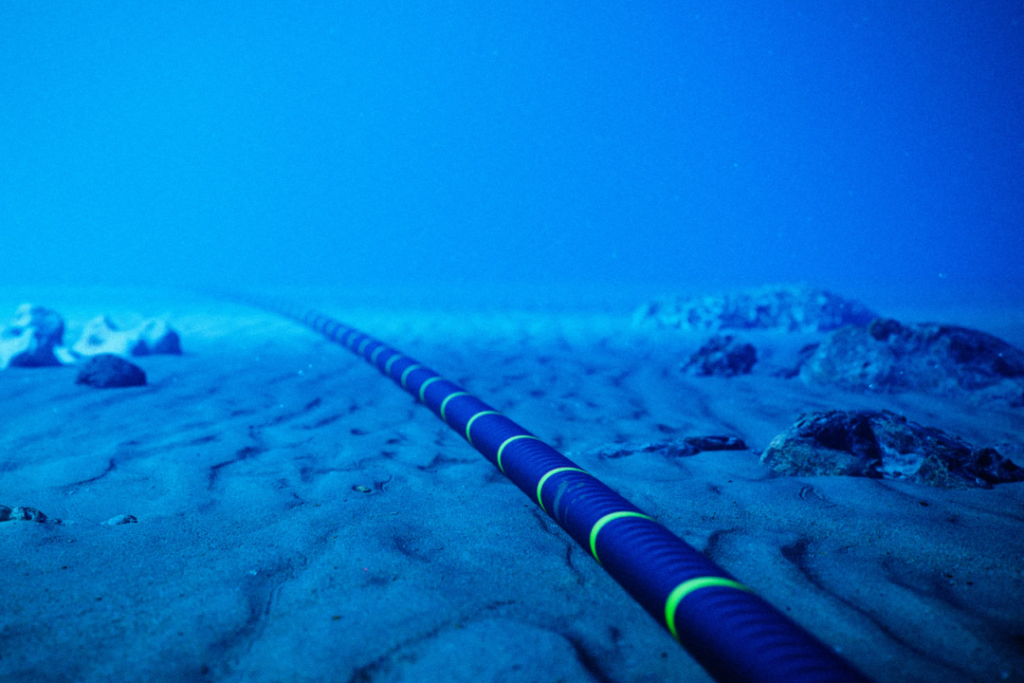Chilean President Gabriel Borich delivered a speech on the construction of submarine fiber optic cable at the Asia-Pacific Economic Cooperation (APEC) CEO Summit on November 15, 2023, in San Francisco, California.
The Chilean government on Wednesday (January 10) announced a partnership with Alphabet’s Google to build the first-ever undersea cable route directly connecting South America and the Asia-Pacific region. The submarine cable line is named “Humboldt”.
According to a Chilean government press release, Humboldt will connect the central Chilean port city of Valparaiso to Sydney, Australia, via 14,800 kilometers (9,200 miles) of fiber optic cable through French Polynesia. The capacity is 144 terabytes (TB) and the service life is 25 years.
Google will work with Chile’s Ministry of National Development and France’s Office des Postes et Télécommunications (OPT) to lay the cable, which is expected to be completed in 2026.

About Submarine Fiber Optic Cables
Submarine fiber optic cables are very demanding in terms of laying environment and technology. For transoceanic cables under the sea, the material must be so strong that it cannot break, but at the same time, it must be so soft that it would be difficult to lay.
On the other hand, the production process of submarine fiber optic cables must be very precise, otherwise, a little flaw may lead to instability and interruption of the electrical signal. Therefore, many countries today do not have perfect submarine fiber optic cable technology
Advantages of Submarine Fiber Optic Cable
Submarine fiber optic cable has many advantages, it is not only a strong structure, but the use of materials is lighter, with the advantages the land cable can not have.
To put it bluntly, the implementation of a submarine fiber optic cable steel frame is convenient, not only the investment is relatively better, but also the construction speed is faster.
Most importantly, underwater fiber cables are more stable and safer, with strong anti-interference ability, and general life can reach about 25 years.
Development of Submarine Fiber Optic Cables in Chile
Back in 2020, Chile established the country’s first submarine cable, with the first underwater fiber optic cable project using a route plan from Japan at the time. The cable runs from Chile through New Zealand to Sydney, Australia, connecting South America with Asia and Oceania. The new “partner”, the “Humboldt” submarine fiber optic cable, connects the central Chilean port city of Valparaiso to Sydney, Australia, via French Polynesia.

Previously, Chile’s Minister of Transportation and Telecommunications Gloria Hutt has said that Chile hopes to expand the capacity of the communications network equipment, to achieve its goal of becoming a digital communications hub in South America.
Public information shows that submarine fiber optic cables are an important carrier of international communications today, and currently, 95% of the world’s communications are realized through submarine cables for data transmission.
Chilean President Gabriel Boric said at a press conference in Valparaiso, “This cable will consolidate Chile’s position as the center of digital activity in South America.”
Boric added that the project will provide thousands of people with “opportunities for new industries, better working and living conditions.”
Brian Quigley, vice president of global network infrastructure at Google Cloud, said that once operational, Humboldt will strengthen the reliability and resilience of digital connectivity across the Pacific through connections to the South Pacific Interoperability Initiative and increased investment in multi-location cables between French Polynesia and Chile. resilience.
Quigley said that since 2016, the Chilean government has been committed to promoting the creation of a direct fiber optic network between South America and the Asia-Pacific region, “and we are working together to make this vision a reality.”
Australian Communications Minister Michelle Rowland said Australia welcomed the new trans-Pacific cable, which connects Australia and Latin America for the first time. This new cable route will enhance Australia’s global connectivity and cooperation with Pacific countries to better participate in the global digital economy.
Moetai Brotherson, President of French Polynesia, said, “Our country’s economic vitality depends on investment in the digital sector. We are excited to partner with the Humboldt Project to continue to advance French Polynesia’s digital economy and keep Tahiti at the forefront of innovation.”
Inventory of Fiber Optic Cables Built by Google
Take stock of all the underwater fiber optic cables that Google has invested in, including projects built solely or in joint ventures with other companies.
1. Curie Cable

The Curie cable starts in Los Angeles, California. It extends along the Pacific coast to Valparaiso, 120 kilometers northwest of the Chilean capital Santiago, covering a distance of 10,000 kilometers.
Although the Curie Cable represents the first intercontinental undersea cable owned entirely by Google and nearing completion, it is only one of 13 undersea internet cables that Google has invested in over the past 10 years.
2. Unity Cable
Unity cable extends from Chikura, Japan to Redondo Beach, Los Angeles, California, USA, with a total length of 9,620 kilometers, jointly owned by many well-known companies, including Google, Telstra, SingTel, KDDI, and Airtel. Unity cable was put into operation in 2010.
3. Southeast Asia Japan Cable (SJC)
The Southeast Japan Cable (SJC), which was launched in 2013, spans 8,900 kilometers of ocean, with landing points in Chikura, Japan; Chung Hom Kok, Hong Kong, China; Nasugbu, the Philippines; Shantou, Shantou; Telisai, Brunei; and Tuas, Singapore.
SJC is jointly owned by Google, Globe Telecom, KDDI, Telenor Indonesia, SingTel, China Telecom, TOT, China Mobile, Chunghwa Telecom, and International Gateway.
The extension of the fiber optic cable, called SJC 2, is currently under construction and is expected to be operational by 2021.
Google has not invested in SJC 2, but Facebook has joined the investment.
4. Faster Fiber Optic Cable
Faster was put into service in 2016 and is 11,629 kilometers long, running from Bandon, Oregon, USA to Danshui, Taiwan, China, with two other landing points in Chikura and Shima, Japan.
The Faster fiber optic cable is operated by Google, KDDI, SingTel, China Telecom, and China Mobile.
There are also Monet Fiber Optic Cable, Junior Fiber Optic Cable, and Pacific Fiber Optic Cable Network (PLCN), etc. We believe that this cooperation with Chile is a win-win option for both parties.
What Other Countries are Saying
Meanwhile, the United States and China have been competing for economic and political influence in Latin America. Undersea cables, which can transmit data ranging from e-mails and bank transactions to military secrets, have become a new battleground in the U.S.-China technological tug-of-war in recent years.

The U.S. State Department on Thursday (Jan. 11) welcomed the news from the Chilean government and Google.
The Humboldt undersea cable route is an example of commercially viable, multi-stakeholder, trusted information and communications technology development that will create new economic opportunities in Chile and beyond,” State Department officials said in a statement. These submarine cables, coupled with secure 5G wireless terrestrial networks, will accelerate the digital connectivity of South America and the Pacific Island countries and their integration into the global economy.”
According to a Reuters investigation, several undersea fiber optic cable projects to Asia that were supposed to connect to China have been blocked or rerouted under U.S. diplomatic pressure. In addition to technological competition, U.S. authorities are concerned about the possibility of spy agencies intercepting undersea cable data.
The development of global undersea fiber optic cables is a major trend and a crucial step in developing technological communication in society.
